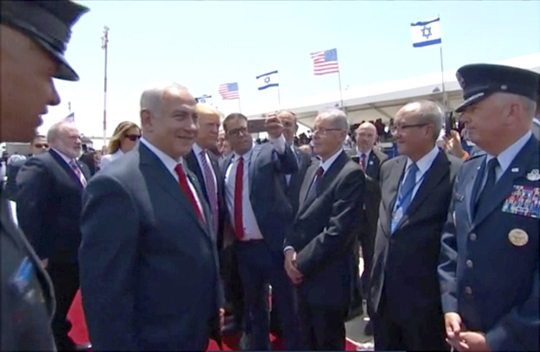Jerusalem, May 23: Warm words were spoken in public by Israeli officials upon President Donald Trump's arrival Monday. Then things got a little off-script at the airport near Tel Aviv.

A pushy Israeli parliament member named Oren Hazan pulled Trump aside and started taking a selfie in the receiving line.
Trump kept a stone face. He might have looked even more dour if he knew the full extent of Hazan's infamous reputation.
Israeli Channel 2 had aired an investigative report alleging that Hazan managed a casino in Bulgaria, where he sampled drugs with guests and procured prostitutes for them. Hazan denied the accusations and sued for libel. He's a member of Prime Minister Benjamin Netanayu's Likud party, but has been shunned.
"It may be worth noting," the Times of Israeli said in its report, "that Hazan was not even supposed to be in the front row of dignitaries."
As Hazan whipped out his phone, Netanyahu stepped into the situation and tried to pull Hazan's arm down.
But Hazan managed to get his money shot anyway - and crop out the prime minister's arm.
Netanyahu and his wife, Sara Netanyahu, also had an unscripted moment, captured by journalists and the official Government Press Office.
The Netanyahus were shown speaking with Trump and first lady Melania Trump. The couples exchanged praise and mutual fandom, then ...
Sara Netanyahu points at Melania Trump: "I talk every place about how great she is, how great you are."
The prime minister inserts: "I can testify to that."
Sara Netanyahu continues: "Because the majority of the people in Israel, unlike the media, they love us."
Her husband is actually not super popular, and she more so, in public opinion polls. Also Israel runs on a parliamentary system, and Netanyahu's Likud party won the last election in 2015 but needed other political factions to form a government.
Sara Netanyahu continued: "So we tell them how you are great and so they love you."
The president interjects: "So we have something very much in common."
The prime minister: "Sounds familiar."
Then Sara Netanyahu closes with: "Very much in common, we will talk about it at dinner. A lot in common, the same media. Anyhow, we'll talk about it."





Comments
Add new comment